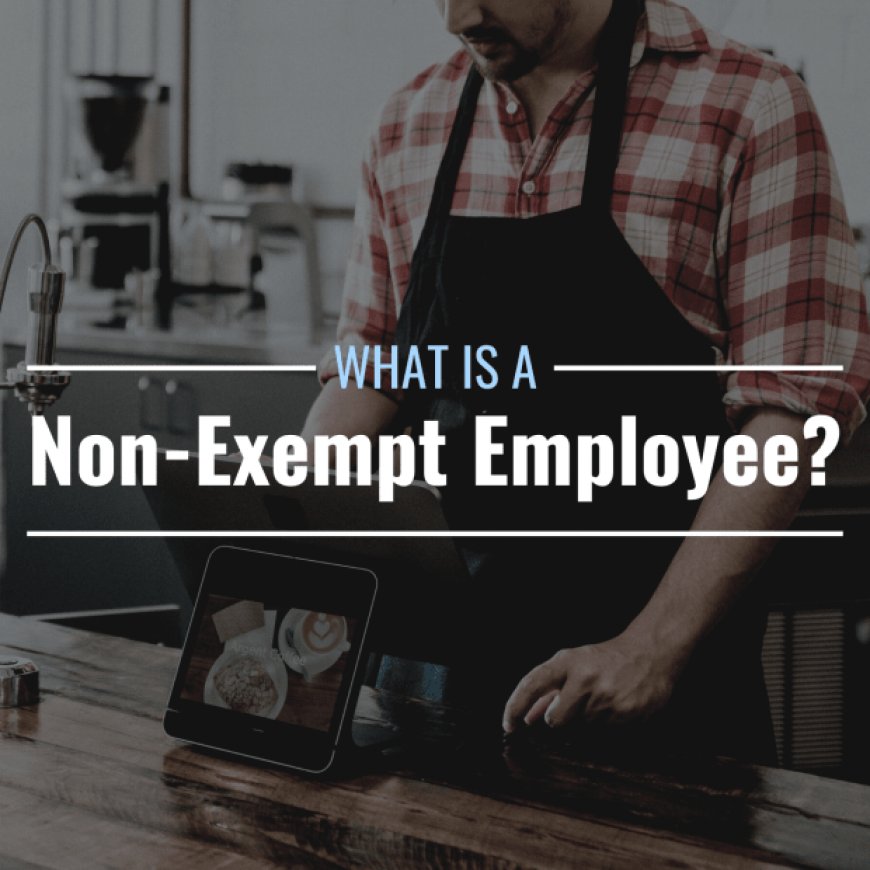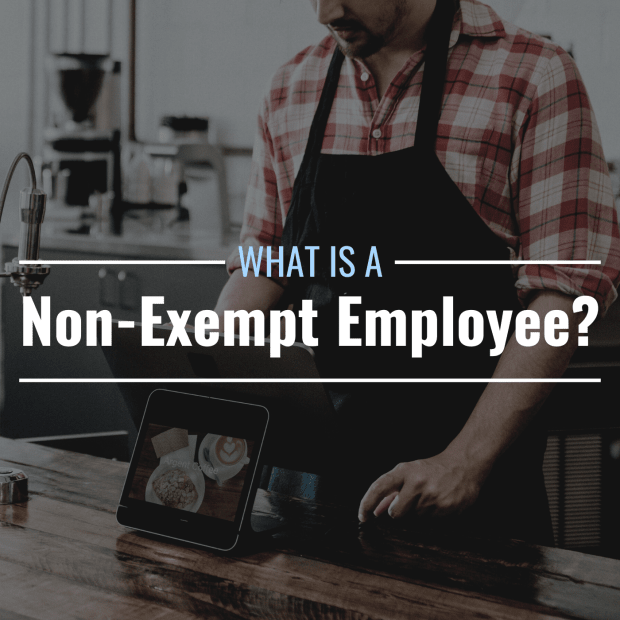What Is a Non-Exempt Employee? Definition, Rights, Pros & Cons
The Fair Labor Standards Act (FLSA), which was initially passed in 1938 but has been amended many times since, details minimum wage and overtime requirements for non-exempt workers in the United States. What Is a Non-Exempt Employee? A non-exempt employee is a worker who is entitled to a minimum ...


The Fair Labor Standards Act (FLSA), which was initially passed in 1938 but has been amended many times since, details minimum wage and overtime requirements for non-exempt workers in the United States.
What Is a Non-Exempt Employee?
A non-exempt employee is a worker who is entitled to a minimum hourly wage and an overtime wage of at least 1.5 times their typical wage for any hours worked per week over 40. These protections are guaranteed to non-exempt employees by the FLSA, so any worker who believes their employer is not in compliance with these standards may seek recourse for wage theft violations by contacting the Wage and Hour Division of the Department of Labor.
The minimum wage that a non-exempt worker is entitled to varies from place to place. The federal minimum is $7.25 per hour, but many states and municipalities have higher minimum wages, and the highest applicable minimum wage in any given location is the one legally guaranteed by the FLSA.
Typically, non-exempt employees are paid by the hour and keep track of their time worked via some sort of physical or digital timecard to ensure payroll accuracy. In some cases, however, non-exempt workers may be paid via salary, in which case their total pay for a period can be divided by their hours worked to ensure minimum and overtime wage requirements are being met.
What Is an Exempt Employee?
Exempt workers are the counterparts to non-exempt employees. They are workers who, due to the nature of their work and the level of their compensation, are exempt from the minimum and overtime wage requirements outlined in the FLSA. Typically, exempt positions are “professional” or “white color” salaried jobs that come with some sort of benefits package.
Exempt positions tend to be associated with higher pay than non-exempt positions, but in practice, this is not always the case. For instance, a non-exempt tipped server at a high-end restaurant in a dense urban area might, between their hourly wage, overtime pay, and tips, take home around $55,000 per year, while an exempt, salaried, mid-level office employee might make only $47,000.
What Positions Qualify for Non-Exempt Status?
Because exempt positions must pay at least $684 a week or $35,568 annually (these are the federal thresholds, but these numbers are often higher in states or municipalities with higher minimum wages), any job that pays less than this is automatically non-exempt.
Additionally, non-exempt workers must work under a supervisor who manages their workflow and assigns their tasks. As such, they should not be required to regularly exercise major judgment or discretion in the normal course of their duties.
What Positions Do Not Qualify for Non-Exempt Status?
According to the FLSA, the following categories of workers may not be categorized as non-exempt:
- Learned professionals
- Creative professionals
- Executive employees
- Administrative employees
- Computer employees
- Outside sales employees
- Highly compensated employees (anyone with annual pay of $107,432+)
- Academic administrators
- Teachers
What Are the Pros and Cons of Working as a Non-Exempt Employee?
Working as a non-exempt employee has a number of benefits, but the status comes with certain drawbacks as well. Some individuals prefer exempt status, while for others, non-exempt status is a better fit.
Advantages of Non-Exempt Status
The most often-cited advantage of working as a non-exempt employee is the ability to receive overtime pay of at least 1.5 times one’s typical wage for any hours worked over 40 in a week. Exempt employees are not eligible for overtime, so they receive the same salary even if they regularly work over 40 hours each week.
Another upside to non-exempt status is the potential to receive tips. Of course, this only applies to certain types of non-exempt workers, specifically those in certain service occupations wherein tipping is common. Hotel staff, restaurant staff, hair and beauty technicians, and bartenders commonly receive tips in addition to hourly and overtime wages.
Disadvantages of Non-Exempt Status
Non-exempt status also comes with some major downsides. First and foremost, since non-exempt workers are typically paid by the hour, if they work fewer hours during a certain week or month, they will receive less pay. Exempt workers’ pay, on the other hand, is virtually guaranteed regardless of how many hours they work.
Additionally, non-exempt positions are much less likely to come with generous benefits packages, although many non-exempt positions do offer some benefits. Most exempt positions do come with a benefits package that includes employer-sponsored healthcare and retirement plans, sick time, and paid time off.
Those who work in non-exempt positions where schedules and hours vary and are not guaranteed may also have a harder time budgeting and planning for recurring expenses than those in exempt positions because each paycheck they receive might look different. If hours are not guaranteed, a non-exempt worker who ends up with lighter-than-usual hours during a given month may have a hard time making ends meet if they don’t have savings.
Frequently Asked Questions (FAQ)
Below are answers to some of the most common questions employees have about non-exempt working status.
What Is a Salaried Non-Exempt Employee?
A salaried non-exempt employee is one who is paid a set sum of money at regular intervals (e.g., bi-weekly) like a typical salaried employee but is considered non-exempt under the FLSA, meaning their salary must adhere to minimum and overtime wage requirements. Salaried, non-exempt positions are less common than hourly non-exempt positions.
Are Non-Exempt Employees Entitled to Breaks?
Federal law does not require employers to provide meal or rest breaks, but most state labor laws do mandate that employees take some kind of meal break depending on shift length. The Department of Labor maintains a webpage that lists meal break requirements for private sector employees.
Do Non-Exempt Employees Get Health Benefits?
The FLSA does not outline any benefits requirements for employees with either exempt or non-exempt status. The Affordable Care Act, however, states that any business with 50 or more employees must offer employer-sponsored health care to all full-time employees.
When it comes to other types of benefits like sick time, vacation pay, and employer-sponsored retirement accounts, no particular requirements exist, so offerings vary quite a bit between employers. That being said, exempt, salaried, white-collar jobs tend to offer the most comprehensive benefits packages.
Can Non-Exempt Employees Take Unpaid Time Off?
Whether non-exempt employees may take elective, unpaid days off without punitive action varies between employers and is entirely up to the employer’s policies and discretion.
Do Non-Exempt Employees Get Paid for Travel Time?
According to the FLSA, non-exempt employees must be compensated normally for any employer-required travel time outside of the home-to-work and work-to-home commutes.
Do Non-Exempt Employees Have to Clock In and Out?
State and federal laws require employers to keep track of the time worked by non-exempt, hourly employees. In most cases, this task falls on the employee themself and is done via some sort of physical or digital timecard system.
Can a Non-Exempt Employee Be Forced to Work Overtime?
The FLSA does not prohibit employers from requiring non-exempt workers to work more than 40 hours per week, but it does require all overtime work to be compensated at a rate of at least 1.5 times an employee’s typical hourly rate. Different states may impose limits on how much overtime a non-exempt employee can be scheduled to work in a given week or month.
What's Your Reaction?



























































